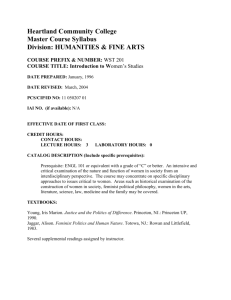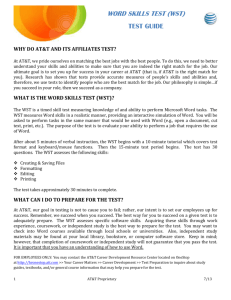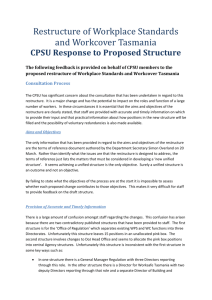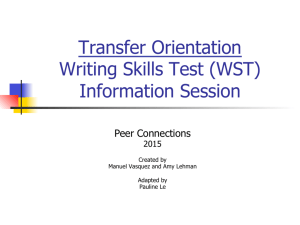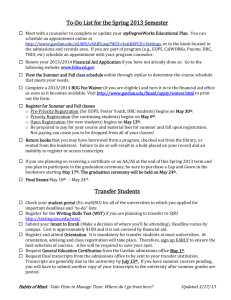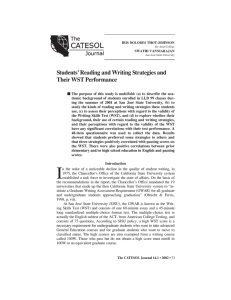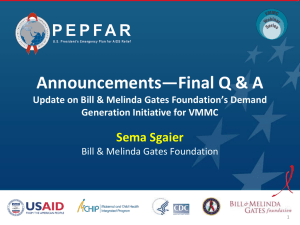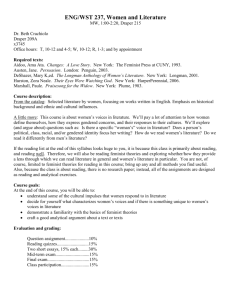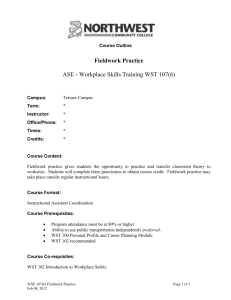An Interview Study of Learner Motivation and Learner Involvement
advertisement
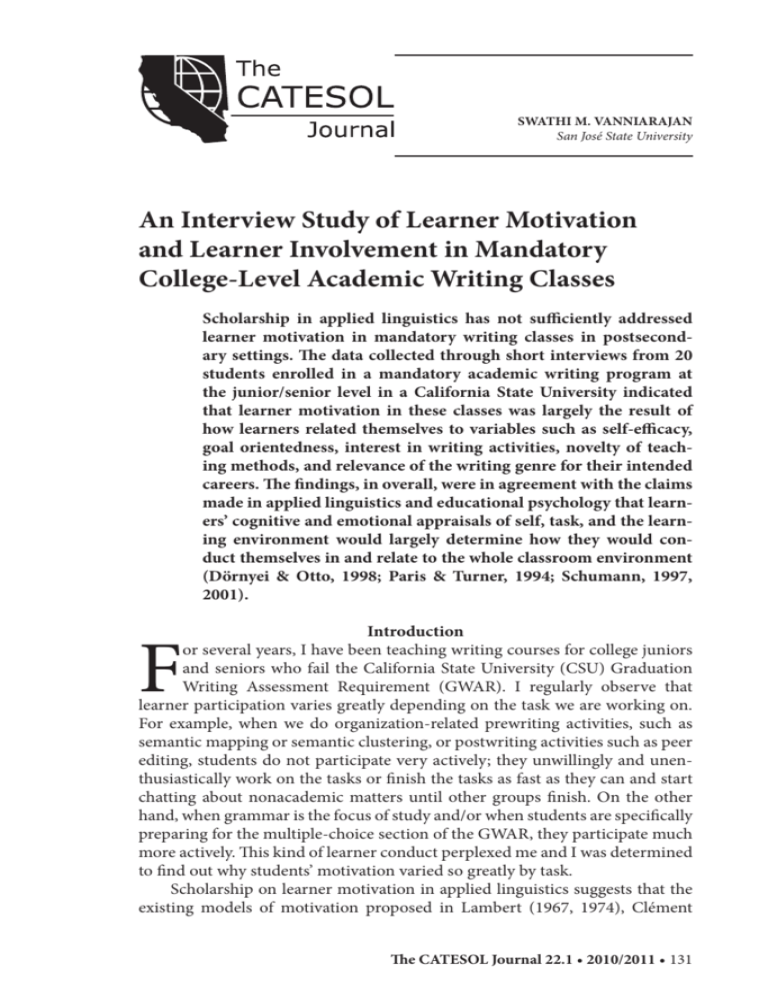
SWATHI M. VANNIARAJAN San José State University An Interview Study of Learner Motivation and Learner Involvement in Mandatory College-Level Academic Writing Classes Scholarship in applied linguistics has not sufficiently addressed learner motivation in mandatory writing classes in postsecondary settings. The data collected through short interviews from 20 students enrolled in a mandatory academic writing program at the junior/senior level in a California State University indicated that learner motivation in these classes was largely the result of how learners related themselves to variables such as self-efficacy, goal orientedness, interest in writing activities, novelty of teaching methods, and relevance of the writing genre for their intended careers. The findings, in overall, were in agreement with the claims made in applied linguistics and educational psychology that learners’ cognitive and emotional appraisals of self, task, and the learning environment would largely determine how they would conduct themselves in and relate to the whole classroom environment (Dörnyei & Otto, 1998; Paris & Turner, 1994; Schumann, 1997, 2001). F Introduction or several years, I have been teaching writing courses for college juniors and seniors who fail the California State University (CSU) Graduation Writing Assessment Requirement (GWAR). I regularly observe that learner participation varies greatly depending on the task we are working on. For example, when we do organization-related prewriting activities, such as semantic mapping or semantic clustering, or postwriting activities such as peer editing, students do not participate very actively; they unwillingly and unenthusiastically work on the tasks or finish the tasks as fast as they can and start chatting about nonacademic matters until other groups finish. On the other hand, when grammar is the focus of study and/or when students are specifically preparing for the multiple-choice section of the GWAR, they participate much more actively. This kind of learner conduct perplexed me and I was determined to find out why students’ motivation varied so greatly by task. Scholarship on learner motivation in applied linguistics suggests that the existing models of motivation proposed in Lambert (1967, 1974), Clément The CATESOL Journal 22.1 • 2010/2011 • 131 (1980, 1986), Schumann (1978), and Crookes and Schmidt (1991) can account for learner success or failure in second language learning in naturalistic settings but not in classroom settings. For example, these models cannot account for why students’ motivation varies by task in a writing classroom. However, two newer theoretical models may shed light on this issue: “the situated motivation model of class participation” (Paris & Turner, 1994) in educational psychology and “Schumann’s neurobiological model of motivation” (Schumann, 1997, 2001) in applied linguistics. Both models suggest that even before stepping into the class, learners cognitively and emotionally appraise the learning environment and decide for themselves how they wish to participate in it. In a way, it is an appraisal of what they want to learn in the class, what skills/knowledge they already have, and what they deem themselves capable of (Bandura, 1982; Paris & Turner, 1994; Pintrich & Schunk, 1996). The present study uses these two models as a framework to examine why learners in GWAR classes do not actively take part in all of the class activities with equal enthusiasm. The article is divided into three parts. The first part briefly summarizes the situated motivation model and Schumann’s neurobiological model of motivation. The second part describes the research study and the findings. The third part discusses the results of the study in terms of the above two models and provides suggestions for writing instructors in similar situations. Situated Motivation Model of Class Participation and Schumann’s Neurobiological Model of Motivation The “situated motivation model” of class participation suggests that the relationship between motivation and classroom participation is highly complex and varies with changes in the learning environment and changes in learner perceptions and evaluations of that environment. According to Dörnyei and Otto (1998), “a broad array of mental processes and motivational conditions play essential roles in determining why students behave as they do” (p. 65) and that “motivation can be defined as the dynamically changing cumulative arousal in a person that initiates, directs, coordinates, amplifies, terminates, and evaluates the cognitive and motor processes whereby initial wishes and desires are selected, prioritized, operationalised, and (successfully or unsuccessfully) acted out” (p. 64). Educational psychologists working in the situated motivation model of class participation have identified many variables that may determine the intricate nature of the relationship between motivation and classroom participation. Some of the variables that are central and significantly important to the present study are self-efficacy, interest in the subject, appraised task value, goal orientedness, and control over the learning process (e.g., Pajares & Miller, 1994; Paris & Turner, 1994; Schunk 1991). Self-efficacy refers primarily to a learner’s perceived coping potential and perceived confidence level in his or her capability, and secondarily to his or her ability to identify opportunities available and use them to achieve the intended goal. In short, it is a measure of a learner’s self-belief system and his or her ability to overcome perceived goal difficulties or fear of failure (Bandura, 1982; Dörnyei & Otto, 1998; Pintrich & 132 • The CATESOL Journal 22.1 • 2010/2011 Schunk, 1996; Sherer et al., 1982). Interest in the subject refers to the level of intrinsic motivation that a learner has about what he or she will be learning from the class activities. It is essentially subjective in nature and is determined to a great extent by learners’ cognitive and emotional appraisals of how pleasant the learning environments are (Krapp, Hidi, & Renninger, 1992; Paris & Turner, 1994). Appraised task value refers to motivation from outside. Bandura (1982) contends that learners may assign a low or high value to a class activity depending on whether the learning and the mastery of the task will make any difference to their academic lives or intended careers. Goal orientedness and control over the learning process are somewhat intricately related. Together, they are a measure of a learner’s commitment to a class activity as well as learning anxiety. Learning anxiety occurs especially when the learner does not have a role to play either in the curriculum or in the evaluation process or in both. In this context, it is worth quoting Dörnyei & Otto (1998), who contend that “educational settings differ from many achievement situations in that most of the decisions and goals are not really the learners’ own products but are imposed on them by the system” (p. 45). The neurobiological model of motivation developed by Schumann (1997, 2001) fits with and complements the situated motivation model of class participation. In Schumann’s model, “emotions are inseparably bound up with perception and cognition” (Young, 1997, p. xi). Schumann (1997) claims that learners’ cognitive appraisal systems are neurologically based on their emotional memory and argues that it is one’s emotional memory that “acts as a filter” and appraises the current stimuli according to the five appraised dimensions proposed in Scherer (1984, 1988): novelty, pleasantness, goal/need significance, coping mechanisms, and self- and social image. According to Schumann (1997, pp. 8-9), “the novelty check assesses whether internal or external stimulation contains novel or unexpected patterns.” Pleasantness check refers to assessing whether the learning event is pleasant or not. If the event is pleasant, then it fosters recurrence of the event; on the other hand, if the event is unpleasant, then it fosters avoidance of it. The goal/need significance check assesses the relevance and meaningfulness of the event in terms of goal proximity, urgency of the goal fulfillment, and the status of the event. The coping potential check determines what the cause of the event is, whether the individual has the ability to cope with the demands of the task/event, whether he or she can adjust to the outcome of the event, and if an untoward outcome is expected, whether it can be avoided or changed. Finally, the compatibility with self- and social image check assesses whether taking part in the event fits in well with the perceived self- and social image of the learner. According to Schumann (1997), “These appraisals guide our learning and foster the long-term cognitive effort (action tendencies) necessary to achieve high levels of mastery or expertise” (p. 36). In short, what Schumann (1997) claims is that in a learning context, learners are active evaluators of what is going on around them and their participation in the course and class activities is largely determined by how they appraise the subsets of the learning environment in terms of their emotional memory. Depending on that, a course or an activity may or may not be (intrinsically) moThe CATESOL Journal 22.1 • 2010/2011 • 133 tivating. Schumann’s neurobiological model of motivation clearly fits in with the situated motivation model since both claim that learner involvement is to be understood as a dynamic process in which the learners’ self-systems interact with the constructs of the learning environment. The situated motivation model of class participation and Schumann’s neurobiological model of motivation, together, in essence, state that learner motivation in a classroom is an interaction of the self-system and the learning environment and the following variables may play a vital role: self-efficacy (subsets: perceived capability, perceived confidence level, perceived coping ability), perceived need for achievement (subsets: goal or need significance, ability to use available opportunities), interest in the subject, appraised task value, goal orientedness (including an ability to prioritize goals and being goal specific), control over the learning process, perceived novelty and pleasantness, and compatibility with social and self-image. The overall claim made by both models is that learners constantly appraise the learning environment both cognitively and emotionally to decide on their level of participation. While the situated motivation model has been studied and verified to some extent in primary and secondary school settings (Garcia & Pintrich, 1994; Ng, 1998; Pajares & Miller, 1994), Schumann’s neurobiological model of motivation still exists only as a theoretical model and has not yet been researched. The current study attempts to apply these two models of motivation to explore why learners in GWAR classes do not actively take part in all of the class activities with equal enthusiasm. The Research Study The San José State University and Its Writing Requirement (WST) The study was conducted at San José State University (hereafter SJSU), which is a major supplier of the workforce to Silicon Valley companies. To meet the university writing requirements, both undergraduate and graduate students are required to pass what is called the “Writing Skills Test” (WST). The WST is given five times a year and undergraduate students are allowed to enroll in upper-division classes only after passing the WST. As such, the WST can be said to be a very important high-stakes exam in the lives of SJSU students. The WST has two parts. In the first part, students answer multiple-choice questions that test various writing skills, skills such as spelling, punctuation, grammar, cohesion, coherence, paragraph organization, logicality, analogy, and vocabulary. In the second part, students write an essay responding to a given topic/quotation. The success rate of nonnative speakers of English who speak languages other than English at home is about 55%, compared to 79% for native speakers of English, who speak English as a primary language at home (CSU GWAR Review Committee, 2003). According to university policy, students who fail the WST twice must first take a writing-support course (LLD 98/99) in the Department of Linguistics and Language Development before retaking the WST. These classes aim to develop writing proficiency in the learners and have a cap of 20 students per class. The classes are graded credit/no credit and they do not count in students’ GPA. They have a common final exam that requires students 134 • The CATESOL Journal 22.1 • 2010/2011 to write an essay (reflecting part 1 of the WST, the direct assessment); however, the common final does not include any multiple-choice format grammar questions (reflecting part 2 of the WST, the indirect assessment of writing). Demographic Profile of the Informants The data were collected through short recorded interviews from 20 students enrolled in a 6-week intensive LLD 98 course in the summer session of 2009. The student composition was as follows: Hispanics 5, Chinese 5, Vietnamese 3, Japanese 3, Korean 2, and subcontinental Indian 2. Of these 20 students, 19 were either permanent residents or naturalized citizens and 1 was an international student. In terms of their level of education, all 20 were undergraduate students. The average age at which these informants started learning English was 10.5 years. However, all of them stated that they had excellent proficiency in English and were using English all the time outside their homes, though for every one of them, including the international student, the language spoken at home was their first language. Data Collection and Coding Procedures As a course requirement, the students came to my office individually between the 3rd and 5th weeks. Interviews lasted 15 to 20 minutes and all 20 students answered all 16 questions (Appendix A), which had been designed to examine some of the major variables identified in the two models of motivation. The interview questions attempted to obtain information from students on their expectations, confidence level, anxiety level, coping ability, relevance of the course, and their aspirations in terms of career goals. The interviews were recorded and transcribed by the researcher. A student assistant then went through the transcriptions to check for accuracy. The transcripts were coded in two different ways. Initially, comments pertaining to the following were identified and grouped (these are called Group A comments): • • • • • The WST; The LLD 98 class; Class activities; Attitude toward writing personal essays; Career and academic goals (further education or employment). Later, comments pertaining to the variables central to the situated motivation model and Schumann’s neurobiological model were identified and grouped (these are called Group B comments): • • • Goal orientedness and need significance (including need for achievement); Self-efficacy and coping potential (including levels of anxiety and confidence); Locus of control; The CATESOL Journal 22.1 • 2010/2011 • 135 • • • Interestingness of the learning environment and pleasantness (including novelty); Appraised task values (including relevance); Self-image and social image. The coding of data into Group A and Group B categories enabled the researcher to gain insights into how the students perceived various constructs of the learning environment. For example, statements such as “I liked what you did” were coded as referring to the class activities (Group A) and interestingness of the learning environment (Group B). The interpretation was that the learning event was motivating because of the interestingness of the learning environment. The coding of data, however, proved to be a difficult task since many comments could be codified in multiple ways. For example, a comment such as “One thing I would like to know is how to finish the multiple-choice section in the amount of time given” was identified as pertinent to the WST, the LLD 98 class, self-efficacy and coping potential, and locus of control. Findings Students’ Attitudes Toward the WST. The first finding of this study is that the WST did not enjoy face validity with this group of students. According to Mousavi (2002), “Face validity refers to the degree to which a test looks right, and appears to measure the knowledge or abilities it claims to measure, based on the subjective judgment of the examinees” (p. 24). All interviewees expressed negative opinions about the validity of the WST. The reasons were many. Of all the reasons, the most important one was that they found the indirect assessment of writing (multiple-choice format) confusing and thought that the multiple-choice test focused on nonessential writing skills. They also said that they somehow lacked the skill to identify errors in the writing passage given on the multiple-choice test. “It is impossible for me to recognize errors,” said one student in an emphatic tone. Added to this is the time constraint with which they had to cope during the exam: “One thing I would like to know is how to finish the multiple-choice section in the amount of time given.” The second most important reason had to do with the nature of the prompt. These students thought that if the prompt were on something that they could relate to, then they could write a good essay; on the other hand, if the prompt happened to be on something they were not familiar with, then they could not think into the topic and come up with good personal examples to write a good essay. The prevalent feeling among students was that some topics were “real difficult” and some topics were “real easy.” Whether or not they would pass the WST, according to them, depended on whether or not they would get an easy topic on the exam. Also, 6 Asian students (including the international student) who had their schooling in their home countries claimed that they had never received training in the genre of “the personal response essay” that is so prevalent in college writing classes in the US. This is precisely the genre required for the WST, as the following example prompt illustrates: 136 • The CATESOL Journal 22.1 • 2010/2011 “Be careful what you wish for because you just might get it.” —William Jones “Think of a time when you got what you wanted, only to discover that the reality of the situation was not what you had expected. What accounted for the difference between your expectations and reality? In a fully developed essay, explain what the quotation means using specific details and examples to support your view.” (GWAR Report, 2003, p. 16) Almost all of the 20 students in the study also said they suffered from WST anxiety; for them, one more failure meant one more semester further into the graduation process with a decreased level of confidence in their capability to pass the test. Comments from these students reflecting this sentiment included the following: “I have only one more semester to complete,” “I can’t take any more classes for graduation,” “I am already worried about the results.” In short, these students saw the WST as a gatekeeping mechanism designed to postpone their graduation. Specific responses in support of this assumption were the following: “It is a waste of time,” “I should have gone to some other school,” “By this time, I would have graduated and be working for some company making money. I am wasting my time preparing for some stupid exam,” “It [the WST] has nothing to do with my engineering skill.” One of the students aptly summarized the student sentiments about the WST in the following statement: “I think there is something wrong with the test, but I don’t know how to say it.” Another student even went to the extent of claiming that the exam was a kind of “racism” since it penalized mostly nonnative speakers of English. Overall, the findings indicated that these students had a negative attitude toward the WST. The main reason is that the test was not a good test since it contained a confusing multiple-choice format that tested grammar in writing (indirect assessment of writing skill) and came with a prompt that would be “the game decider.” More important, in their opinion, they had failed the exam twice not because they lacked language ability but because it was an unfair test. Students’ Attitudes Toward the LLD 98 Class. The second major finding is that the students did not find the LLD 98 class very beneficial. In their opinion LLD 98 was “just another writing class” with a minimal WST-type grammar component and heavy emphasis on writing activities with which they were already familiar. Only 9 out of 20 students thought that the class could prepare them to pass the WST; the remaining 11 had reservations about it. Also, 12 students expressed opinions that the LLD 98 final should have multiple-choice questions just as on the WST. Failing that, in their perception, passing the class would not guarantee that they would pass the WST. Furthermore, 3 students complained that the class incurred additional expense, postponed their graduation process, and had no tangible benefit for them. The fact that only 50% to 60% of the students enrolled in the LLD 98/99 classes pass the WST corroborate the students’ opinion. In addition, as many as 15 students thought that the fact they were enrolled in a writing class affected their confidence level and self-image; however, for the sake of graduation, they were reconciled to being placed in the mandatory writing class. “My English is really good,” was a recurThe CATESOL Journal 22.1 • 2010/2011 • 137 ring comment. One student asked, “I consistently get A grades in all of my term papers and so why do I have to take this class and the test to prove my English proficiency?” What mattered to them most was that the class did not guarantee a pass in the WST or would not be a substitute for the WST and that they had to take the class especially when they were close to graduation. In summary, the findings clearly indicated that the students did not see the LLD 98 writing class as an opportunity to improve their writing skills but a preparation course to pass the WST. As such, it was the grammar part that interested them because they could recognize that they were weak in analyzing grammar, especially in identifying errors in connected discourse. Last, the fact that they were enrolled in a writing class especially when they were close to their graduation process did not sit well with their self- and social image. Students’ Attitudes Toward Personal Writing. Student attitudes toward personal writing, the writing genre that was being tested in the WST, were somewhat negative. They were questioning the value of learning to write personal essays. Engineering and nursing students claimed that they would not be required in their jobs to do any kind of academic writing, let alone writing personal essays. “All I am going to write is software coding” and “I am not going to write personal essays; all I am going to do is to interpret medical records or fill in details in some medical forms” were some of the specific remarks made by these students. Engineering students in the program thought that the university was wasting their time by preventing them from taking upper-division classes with its emphasis on writing personal essays. “It [the WST] has nothing to do with my engineering skills” was a comment from an engineering student. Business major students said, in contrast, that it was possible that they might have to do some writing if they ended up in careers related to marketing or analyzing market trends; but even in these situations, according to them, writing would be minimal at least during the first few years of their careers. As such, in their opinions, the WST and LLD 98/99 classes were merely wasting their money and time. Overall, almost all of the interviewees wondered how the learning of the writing of personal essays was going to help them in their professional careers. As such, it could be said that student attitudes toward writing personalreaction essays were not favorable at all. Students’ Attitudes Toward Class Activities. The most important finding with regard to student attitudes toward class activities was that they liked group and pair brainstorming activities, practice essay writing on past exam prompts, and practice grammar tests; however, they did not like organizationrelated prewriting activities such as semantic mapping and semantic clustering and peer-editing sessions. The group or pair brainstorming was an enjoyable activity because in students’ opinions, they could talk about what they thought about the topic: “I find the class more interesting when the entire class participated during a brainstorming session.” One student said that the brainstorming activity made her realize that there was always “another side.” The writing of essays on past exam topics was another favorite activity with these students and attendance was always 100% on the days they had to take the practice essaywriting test. Students also claimed that they benefited a lot by taking part in 138 • The CATESOL Journal 22.1 • 2010/2011 practice grammar (multiple-choice) tests, which were given every week. They especially liked the way their responses to the multiple-choice items were handled. The responses were item analyzed and focused explanations were given to the items with low item facility. Interestingly, after the presentation of statistics for each item, the class had intensive brainstorming sessions analyzing possible reasons for their choices of the distracters. This kind of brainstorming, supplemented with the instructor’s explanations as to what the correct answer was, made students take the practice grammar tests seriously. Some of the appreciative remarks received during the interview were as follows: “I liked what you did,” “Thanks for working on the wrong answers; it is more important to me to know why,” “The grammar exams that we go over in the class are very helpful,” and “You did a lot of work.” Of the students, 14 claimed that it was a “new method” and that they were able to learn a lot by analyzing the grammar errors made not only by them but also by others, especially for the items that proved to be very difficult for every one of them. The reasons for the students’ negative attitudes toward the prewriting activities such as semantic clustering were that they had been working on these activities continually every semester for the last four or five semesters. “It’s boring to repeatedly do these activities,” “I am not good at it,” “I don’t like doing these because I don’t have enough time to work on these during the exam” were some of the comments. With regard to their dislike for peer-editing activities, almost every student stated that he or she did not learn anything from these activities. Some learners thought that their peers had not provided useful feedback to them. They also said that they never paid any attention to peer corrections for two reasons: One, they did not believe that the other person had superior writing skills to theirs, and two, they believed that corrections should come from instructors. Overall, in their opinion, peer editing should not be practiced at all in writing classes. It was disheartening to learn from these students that they did not have a good opinion about peer work. It is possible that this group of informants was an exception since all of the students were nonnative speakers and had also failed the WST at least two times. However, informal conversations on this finding with my colleagues who were teaching this course revealed that these students were not an exception. The predominant attitude among the students who were taking the LLD 98/99 classes seemed to be that peer editing as a class activity was a waste of time. They would rather the instructor do the job and give them constructive feedback. Discussion The goal of this research project was to determine why students in the LLD 98 class were not taking part in all of the class activities with equal enthusiasm. The answer I obtained did not turn out to be a simple like or dislike of some activities. In what follows, I will initially interpret the findings in terms of the situated model of motivation and then in terms of Schumann’s neurobiological model of motivation. The variables that are central and significantly important in the situated motivation model of class participation are goal orientedness, self-efficacy, inThe CATESOL Journal 22.1 • 2010/2011 • 139 terest in the subject, appraised task value, and control over the learning process. Students under study had just one goal, that of passing the WST. It is obvious from their statements that they needed to pass the WST before the end of summer (goal and need significance) to move on in their academic lives. Unfortunately, attaining this goal, in the students’ perceptions, was a difficult endeavor. Their perceived goal difficulty was essentially two-dimensional, the confusing-grammar part and the anxiety-causing essay part, especially with its game-deciding prompt. The difficulty with the grammar part was due to their inability to identify errors and the difficulty with the prompt was due to their inability to think on the topic in the tense testing environment and finish writing the essay within the allotted time. This was evident from the following students’ comments: • • • • • • “One of my problem [sic] is that I cannot get down to think in the exam.” “If prompt looks complicated, I give up easily.” “If I can’t get it done the first time, then I give up easily.” “Though I know how to write, I am worried about the prompt.” “Writing a timed essay is too difficult for me—actually not writing but thinking.” “Grammar is my weak point.” In spite of the perceived goal difficulties with regard to the WST, the students were somewhat confident that they would somehow pass the WST as the following self-efficacy statements indicated: • • • “I am confident I’ll pass WST this time.” “I can get higher cutoff score in the grammar part to pass the WST, I guess.” “I believe I write and speak English well—my GPA is 3.7.” Literature on motivation and class participation suggests that high-efficacy students with low outcome expectations would protest and grieve while low self-efficacy students with high outcome expectations would end up in selfdevaluation and depression (Bandura, 1982). The students under study seemed to belong to the high self-efficacy group with low outcome expectations and so it was not surprising that they were protesting and also had major grievances against the WST and the class. The repeated failures have also caused a great deal of anxiety (about the prompt and about their success), decreased confidence level (to finish writing the essay and finish the multiple-choice test within the time limit), and decreased coping potential to handle the WST. These could also be the reasons the WST enjoyed low face validity with these students. Added to this, it frustrated them that the WST tested skills (the ability to write personal essays and the ability to identify errors in connected discourse) that are not relevant for their future academic or prospective careers, at least in their perception. The way they were expressing their frustration about their in140 • The CATESOL Journal 22.1 • 2010/2011 ability to pass the WST suggested that their coping potential had suffered from a sense of lack of reality that was due to their incapability to differentiate their English language skills from their academic writing skills. They were not aware that these two skills are not synonymous, as Cummins (1984) has pointed out in his CALP/BICS distinction. Also, nowhere in the data was there any kind of indication from these students that their goal difficulty and their inability to cope with the demands of the WST could be due to anything other than their perceived inadequate ability to interpret prompts. The prompts, as instructors know, tend to elicit the ability of the writer to reflect on the topic and write an appropriate response to it. It is possible that these students did lack these abilities but were not aware of it. Their claim that they benefited a lot from the peer and group brainstorming sessions on the essay topics indirectly supports this possibility. One of the hallmarks of self-efficacy is maximally making use of opportunities available to achieve one’s goals. These students were maximally taking part in practice tests in both grammar and essay writing because in their perception that was the best way of overcoming the perceived difficulties in passing the WST. It then becomes apparent that the main reason the students were taking the practice tests in both grammar and writing seriously was that in their cognitive appraisal system, that was the course of action they needed to take. It is the only strategy by which they could overcome their fear of one more failure in the WST. This is well captured in Wood and Bandura’s (1989) definition of self-efficacy as “beliefs in one’s capabilities to mobilize the motivation, cognitive responses, and courses of action needed to meet given situation demands” (p. 408). Students’ enthusiastic participation in the practice tests was also an indication that they were indeed goal oriented and had a need for achievement. At least for one student, “passing the WST is more important to me now.” The students under study did not have much faith in the LLD 98 class because in their opinion, it was just another writing class and not a class that would prepare them to pass the WST (relevance toward the goal) because of the absence of a grammar component in the final exam. Further, they could do nothing about how they were to be tested in the LLD 98 final (locus of control). It could be for these reasons that they were cognitively appraising which of the class activities would enable them to pass the WST and which would not. In general, an instructor in similar situations would expect that these learners should make use of all the opportunities available to increase their chances of passing the WST. As such, it was expected that these students would sincerely take part in all of the class activities especially because they had failed the exam at least two times. This assumption, however, proved to be wrong. The data indicated that in students’ perceptions, only the activities that could improve their chances of passing the WST entailed active involvement (relevance). If they had any control in the learning process, it is obvious that they would have preferred the following activities alone: many more class discussions on various possible essay topics, grammar in discourse activities, item analyses (analyses of responses to distracters), and practice tests in both grammar and writing. In other words, only these activities enjoyed high task values in these students’ The CATESOL Journal 22.1 • 2010/2011 • 141 perceptions. The interview data suggested that the students actually came to the class with a preconceived notion that their success or failure in the WST would depend entirely on the kind of prompt that they would get in the exam. Since the choice of the prompt was also not within their control, it was obvious that they were placing their bets on doing well on the multiple-choice section of the WST, because a higher score in the multiple-choice section would allow them to have a lower essay score if the prompt proved to be difficult for them. In short, they had a clear idea of what their specific goal was and how it should be attained. This was evident from one of the student comments: “All I want to learn is to learn about the WST and to learn the secrets of the test and the ins and outs of how to overcome the test.” The finding that students did not find the LLD 98 class environment “interesting” could be because the LLD 98 class was more of a writing class and they had been working on these activities for a long time. With the delineation of interest as a psychological state, lack of enthusiasm to participate in peer activities and prewriting activities raises an interesting question of whether the students were disinterested in the task or the tasks were uninteresting. In my opinion, students were not enthusiastic about organization-related prewriting and peer-editing activities because they would not be able to use these activities during the WST. In this respect, these tasks were irrelevant for achieving their intended goal and were appraised to have low task values. So far as the peerediting activities were concerned, it seemed that they did not have much conviction about them. As per the data, they had self-determined even before they had stepped into the class that they were not going to learn anything new from peer-editing activities. Students’ enthusiastic participation in the brainstorming activities on the prompt, in contrast, was an indication that these tasks enjoyed high task values. It was also a sign that prompts did matter a great deal to them and that they did indeed want to learn how the possible topics could be approached. Another activity that enjoyed high task value was the analysis of student performance in the practice grammar tests through item-analysis statistics. The teaching activity seemed to have interested them greatly because it was relevant, especially the instructor’s explanations as to why their choices of distracters as answers were wrong. This was evident from the following comment from a student: “I like revising grammar test—your statistics how many pass/fail—real good.” Such comments were an indication that they were motivated to take part only in those activities for which in their appraisal system they could feel a sense of relevance. In terms of Schumann’s (1997, 2001) five appraisal dimensions, novelty, pleasantness, goal or need significance, coping ability, and compatibility with self- and social image, the findings indicated that the WST and the LLD 98 class did not enjoy at least two of the five dimensions: pleasantness and compatibility with self- and social image. That the informants were required to pass various writing exams and that they had to constantly enroll in various writing classes during their graduation process could not only have worn out the novelty and the pleasantness effect for the writing classes completely but could also have affected their ego strength. Since they thought that their English language pro142 • The CATESOL Journal 22.1 • 2010/2011 ficiency was satisfactory and since they were earning A grades in their term papers, the mandatory requirement of enrolling in the LLD 98 class did not sit well with their self- and social image. Even their unfavorable attitude toward peer-editing activities could have been due to the effects of social image and need significance. Their knowledge that the peer had also failed the WST two times could have made them wonder what they could possibly learn from the other person by taking part in peer activities. After all, what is the guarantee that their peer-provided corrections were absolutely correct? The coping ability could be said to have been put to the test since all of them had failed the WST two times. The GWAR Report (2003) also recognizes this paradigm in the following statement: “Students who retake the exam because they were not successful in the first attempt continue to have difficulty in subsequent attempts. Pass rates for repeaters are almost always lower than the rate for first-time takers because the repeater pool consists solely of students who have already demonstrated that timed essay exams pose challenges for them” (p. 23). In summary, these students did not seem to have strong faith in their selfefficacy or coping potential to pass the WST though they claimed that they had adequate proficiency in English. They did suffer from a lack of interest in the subject and incompatible self- and social image as they were required to take the LLD 98 class based on the results of a writing test in which they did not have much faith. Their goal being to pass the WST, they seemed to have assigned inordinately high task values to activities that were novel and relevant and that they would use in the testing environment to increase the chances of passing the WST; they seemed to have assigned relatively low values to the tasks that in their perception were not relevant for their academic or intended career. Their perception of inability to have a say in the control over the learning and testing process had resulted in test anxiety and decreased levels of confidence and coping potential. That only 50% to 60% of those who pass the LLD 98 class pass the WST exasperated them and had not only increased their anxiety to a great extent but had also taken away the pleasantness of taking the LLD 98 class. The students had a clear specific goal, that of passing the exam; they also understood that attaining the goal alone would enable them to move on in their academic lives, an indication that they did have a sense of need significance. Unfortunately, they did not realize that they were lacking in adequate writing ability or necessary skills to interpret the prompt and come up with good personal examples. On the other hand, in their perception, the goal difficulty was mainly due to the prompt (“the game decider”). It was an indication of their misguided faith in their self-adequacy in writing skills, while in truth they might not have had the necessary writing skills to pass the WST, and it is for this reason their confidence level was somewhat insecure and their coping mechanisms were not adequate for them to overcome the perceived fear of failure. What emerged from the interpretation of the findings was that students’ discontinuous class participation in the writing program under study had some underlying rationale. It was not a simple like or dislike of activities. In fact, for an understanding of it, one had to go well beyond the classroom and delve into the emotional and cognitive appraisal systems of the learners. The CATESOL Journal 22.1 • 2010/2011 • 143 Recommendations In light of the findings and the discussion, the following suggestions are made to improve the level of motivation in students who have to take mandatory writing courses at the junior/senior level in colleges/universities. 1. Writing instructors in advanced writing classes should conduct a short survey at the beginning of the semester. They should provide a list of activities that are likely to be practiced in the class and ask students to rank-order them in terms of novelty, familiarity, relevance from the course and the exam point of view, and usefulness in their intended academic and prospective careers. Based on the results of the survey, the instructor should start the semester with the most meaningful ones for the learners first and then gradually move on to the less meaningful ones but regularly educating the students on the values of the less meaningful ones. Such a teaching strategy can increase learners’ coping potential and can also increase student interest in class activities with appraised low task values. 2. In the writing finals, test administrators should make it a requirement that students turn in their prewriting work along with the essays. If the students start using the prewriting strategies seriously, they may come to recognize that the use of these strategies not only enhances the quality of their essays but also decreases their level of anxiety and the overall time needed to write the essay, resulting in increased capability and coping potential. For this to happen, students are to be given prewriting time of at least 30 minutes and some credit for their prewriting work. Note that according to the data, the students were not questioning the value of the prewriting activities but were reluctant to take serious part in these activities because in their opinion they were not going to use them because of time constraints on the exam. There is some truth in their contention and this is primarily due to the mismatch between process-oriented teaching of writing and product-oriented testing of writing. We test students’ writing abilities solely on the basis of their products and not by their abilities to use the strategies that we teach them in class. A negative consequence of this suggestion is that it increases the workload for instructors and for those who take part in the evaluation process. 3. It is important that we as writing instructors emphasize in our classes the importance of peer-editing activities to the students. Students generally think that they do not have the capability to identify errors in the essays written by their peers and that they will not learn from their peers. Yet, everyone’s strengths are not the same. Some students will have strengths in vocabulary, some in organization, some in writing introductions, and some in grammar and so on. As such, students should be educated and be made to experience first-hand that they can in fact learn from other students’ strengths. 4. It is suggested here that some practice is provided in English 1A and English 1B classes at both community colleges and universities to prepare students for the GWAR. The data clearly indicated that students were not familiar with indirect testing of writing. In indirect testing of writing, grammar and other aspects of writing are tested in connected discourse. Students do not 144 • The CATESOL Journal 22.1 • 2010/2011 seem to be familiar with this kind of testing. Preparing students in English 1A and 1B for this kind of testing may serve another purpose also. It may make students realize that identifying errors in connected discourse and identifying errors in their peers’ writings are more or less the same in terms of skills required and so it may motivate them to some extent into accepting peer-editing activities as relevant ones. Suggestions for Further Research. This is a pilot and preliminary study carried out at a very small scale. Some of the limitations of the study could be the small number of subjects and a limited number of questions. Future studies should have a larger number of participants. In spite of its limitations, the study has clearly indicated that this student population is significantly different from student populations in other writing classes. As such, in my opinion, the common pedagogical assumptions that we make with regard to the teaching of writing in classes such as English 1A and 1B cannot be generalized to the teaching of writing in all writing classes; classes such as the one under study may be an exception. Further research studies should be conducted to find out how student populations in different writing programs differ from one another in terms of the variables central to the situated motivation model and Schumann’s neurobiological model of motivation. Conclusion. The findings of the study have indicated that a learner’s selfsystem and his or her emotional appraisal of the learning environment may actually regulate how he or she participates in the class. As such, the level of motivation and the level of learner participation in class activities may change from one learning situation to another. The study has also shown that learner motivation in mandatory writing classes at the advanced levels may be of a special nature bounded by emotional dimensions that are unique to the situation. Finally, it became apparent from the findings that the variables that affect whether or not learners will actively take part in class activities have much to do with their (learners’) self-systems. The findings of the study confirm the claims made by the proponents of the situated motivation model of class participation and Schumann’s neurobiological model of motivation that students are active interpreters and evaluators of tasks and the learning environment in light of the salient self-structures in their minds such as goal orientedness, self-efficacy, relevance, mastery and familiarity of the activities being taught, interest, perceived task value, control over the learning process, and compatibility with self and social image. Author Dr. Swathi Vanniarajan has been teaching graduate and undergraduate classes in second language acquisition, psycholinguistics, curriculum and assessment in TESOL, and remedial writing in the Department of Linguistics and Language Development, San José State University, since 1995. He has a passion for working on and reading about issues related to the human brain, mind, and language processing. The CATESOL Journal 22.1 • 2010/2011 • 145 References Bandura, A. (1982). Self-efficacy mechanism in human agency. American Psychologist, 37, 122-147. Clément, R. (1980). Ethnicity, contact, and communicative competence in second language. In H. Giles, P. Robinson, and P. Smith (Eds.), Language: Social psychological perspectives (pp. 147-177). Oxford, England: Pergamon. Clément, R. (1986). Second language proficiency and acculturation: An investigation of the effects of language status and individual characteristics. Journal of Language and Social Psychology, 5, 271-290. Crookes, G., & Schmidt, R. (1991). Motivation: Reopening the research agenda. Language Learning, 41(4), 469-512. CSU GWAR Review Committee. (2003). A review of the CSU graduation writing assessment requirement (GWAR) in 2002. Retrieved January 18, 2011, from http://www.calstate.edu/acadaff/GWAR_review_2002_rpt.pdf Cummins, J. (1984). Wanted: A theoretical framework for relating language proficiency to academic achievement among bilingual students. In C. Rivera (Ed.), Language proficiency and academic achievement (pp. 2-19). Clevedon, England: Multilingual Matters. Dörnyei, Z., & Otto, I. (1998). Motivation in action: A process model of L2 motivation. Working papers in applied linguistics: Vol. 4 (pp. 43-69). London: Thames Valley University. Retrieved January 19, 2011, from http://eprints .nottingham.ac.uk/archive/00000039/00/Motivation_in_action.pdf Garcia, T., & Pintrich, P. R. (1994). Regulating motivation and cognition in the classroom: The role of self-schemas and self-regulatory strategies. In D. H. Schunk & B. H. Zimmerman (Eds.), Self-regulation of learning and performance: Issues and educational applications (pp. 127-153). Hillsdale, NJ: Lawrence Erlbaum. Krapp, A., Hidi, S., & A. Renninger. (1992). Interest, learning, and development. In A. Renninger, S. Hidi, & A. Krapp. (Eds.), The role of interest in learning and development (pp. 3-26). Hillsdale, NJ: Lawrence Erlbaum. Lambert, W. E. (1967). A social psychology of bilingualism. Journal of Social Issues, 23, 91-109. Lambert, W. E. (1974). Culture and language as factors in learning and education. In F. Aboud and R. Meade (Eds.), Cultural factors in learning and education. Bellingham: Fifth Western Washington Symposium on Learning. Mousavi, S. A. (2002). An encyclopedic dictionary of language testing (3rd ed.). Taiwan: Tung Hua Book Company. Ng, Chi-hung. (1998, November/December). A diary study of students’ classroom learning and motivation. Paper presented at the Annual Conference of Australian Association for Research in Education, Adelaide. Pajares, F., & Miller, M. D. (1994). Role of self-efficacy and self-concept beliefs in mathematical problem solving: A path analysis. Journal of Educational Psychology, 86(2), 193-203. Paris, S. G., & Turner, J. C. (1994). Situated motivation. In P. R. Pintrich, D. Brown, & C. E. Weinstein (Eds.), Student motivation, cognition, and learning (pp. 213-237). Hillsdale, NJ: Lawrence Erlbaum. 146 • The CATESOL Journal 22.1 • 2010/2011 Pintrich, P. R., & Schunk, D. H. (1996). Motivation in education: Theory, research, and applications. Englewood Cliffs, NJ: Prentice-Hall. Ryan, R. M., & Powelson, C. L. (1991). Autonomy and relatedness as fundamental to motivation and education. Journal of Experimental Education, 60(1), 49-66. Scherer, K. R. (1984). Emotion as a multicomponent process: A model and some cross-cultural data. In P. Shaver (Ed.), Review of personality and social psychology: Vol. 5. Emotions, relationships, and health (pp. 37-63). Beverly Hills, CA: Sage. Scherer, K. R. (1988). Criteria for emotion-antecedent appraisal: A review. In V. Hamilton, G. H. Bower, & N. H. Frijda (Eds.), Cognitive perspectives on emotion and motivation (pp. 89-126). Dordrecht, the Netherlands: Kluwer. Sherer, M., Maddux, J. E., Mercandante, B., Prentice-Dunn, S., Jacobs, B., & Rogers, R. W. (1982). The self-efficacy scale: Construction and validation. Psychological Reports, 51, 663-671. Schumann, J. H. (1978). Social and psychological factors in second language acquisition. In J. C. Richards (Ed.), Understanding second and foreign language learning (pp. 163-178). Rowley, MA: Newbury House. Schumann, J. H. (1997). The neurobiology of affect in language. Language learning monograph series. Malden, MA: Blackwell. Schumann, J. H. (2001). Appraisal psychology, neurobiology, and language. Annual Review of Applied Linguistics, 21, 23-42. Schunk, D. H. (1991). Self-efficacy and academic motivation. Educational Psychologist, 26(3), 207-231. Wood, R., & Bandura, A. (1989). Impact of conceptions of ability on self-regulatory mechanisms and complex decision making. Journal of Personality and Social Psychology, 56, 407–415. Young, A. J. (1997). I think, therefore I’m motivated: The relations among cognitive strategy use, motivational orientation and classroom perceptions over time. Learning and Individual Differences, 9(3), 249-283. Young, R. (1997). Series editor’s foreword. In J. H. Schumann, The neurobiology of affect in language. Language learning monograph series (pp. ix-xi). Malden, MA: Blackwell. The CATESOL Journal 22.1 • 2010/2011 • 147 Appendix A Short-Interview Questions 1. When did you start learning the English language if it is not your first language? What language do you use most often? At home? At school? What do you think about your English language proficiency level? 2. What is your long-term goal? What role do you think your knowledge of English language will play in it? 3. Do you enjoy writing—any kind? Do you enjoy reading in English? What do you read most? 4. What do you feel about academic writing? Do you consider academic writing in English difficult to learn? Why? 5. How do you feel about the WST? Why do you think you failed the WST two or more times? Do you expect to pass the exam this time? What was your reaction when you failed the WST the second time? 6. How important it is that you pass the WST this time? 7. Do you suffer from some kind of language anxiety because English is not your home language? In your opinion, how difficult is the English language? 8. Do you suffer from some kind of test anxiety about the (WST) exam (prior to taking the exam and during the exam)? If so, what do you think you as a test taker will have to do to get rid of it? 9. What are the things that you like about WST? What are the things that you hate about WST? 10. What is your confidence level in passing the exam this time? Do you think that the LLD 98 class is preparing you really well to pass the WST? Is your confidence level at this time different from the confidence level that you had at the time you enrolled in the class? 11. Do you think that the LLD 98 class is preparing you really well to write personal essays? Which of the writing activities in the class do you think are preparing you well for the exam—examples like silent reading, brainstorming, semantic mapping, clustering, paragraph organization, proofreading, peer editing, practice tests? 12. Do you think that the LLD 98 class is preparing you really well to take the multiple-choice test? What activities in the class in your opinion prepare you for taking the multiple-choice test? 13. How do you feel about doing group work, pair work, and peer edit? In other words, what is your attitude toward picking your classmates’ brain during brainstorming and peer-editing sessions? Did you learn anything from peer editing? 14. Do you seek any external help in learning to write academic essays, like a paid editor or tutor? How well are you preparing yourself for the WST? 15. What is your preferred teaching method so far as this class is concerned? 16. In your intended career, do you think you will have to do a lot of writing? What kind of writing do you think you will have to do in your career path? 148 • The CATESOL Journal 22.1 • 2010/2011
